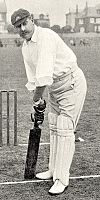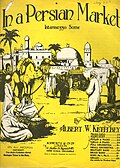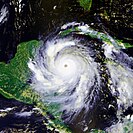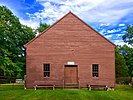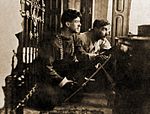Wikipedia:Today's featured article/August 2016
| << | Today's featured articles for August 2016 | >> | ||||
|---|---|---|---|---|---|---|
| Su | Mo | Tu | We | Th | Fr | Sa |
| 1 | 2 | 3 | 4 | 5 | 6 | |
| 7 | 8 | 9 | 10 | 11 | 12 | 13 |
| 14 | 15 | 16 | 17 | 18 | 19 | 20 |
| 21 | 22 | 23 | 24 | 25 | 26 | 27 |
| 28 | 29 | 30 | 31 | |||
August 1
Ricketts Glen State Park is a Pennsylvania state park and American National Natural Landmark on 13,050 acres (5,280 ha) in Columbia, Luzerne, and Sullivan counties. The park has 24 named waterfalls along Kitchen Creek, as it flows down the Allegheny Front escarpment over four rock formations from the Devonian and Carboniferous periods. The earliest recorded inhabitants of the larger watershed were the Susquehannocks. The park is named for R. Bruce Ricketts, who built the trail along the waterfalls and operated a hotel there from 1873 to 1903. Ricketts made his fortune clearcutting much of what is now the park, but preserved about 2,000 acres (810 ha) of old-growth forest in its three glens. The park opened in 1944. The Benton Air Force Station, a Cold War radar installation in the park, operated from 1951 to 1975 and still serves as airport radar for nearby Wilkes-Barre and as the Red Rock Job Corps Center. The park is home to a wide variety of plants and animals and was named an Important Bird Area by the Audubon Society. The state’s Department of Conservation and Natural Resources named it one of "25 Must-See Pennsylvania State Parks". (Full article...)
August 2
Interstate 68 (I-68) is a 112.9-mile (181.7 km) Interstate highway in the U.S. states of West Virginia and Maryland, connecting Interstate 79 in Morgantown to Interstate 70 in Hancock, and is also part of the Appalachian Development Highway System. In Maryland, it parallels the historic National Road between Keysers Ridge and Hancock. A road cut at one of the many mountain ridges it crosses, Sideling Hill, exposes geological features that have become a tourist attraction. From 1965 until the freeway's construction was completed on August 2, 1991, its segments were designated as U.S. Route 48. It crosses Allegany, Garrett, and Washington counties in Maryland, and Preston and Monongalia counties in West Virginia. The two largest cities connected by the highway are Morgantown and Cumberland, Maryland. Although the freeway serves no major metropolitan areas, it connects western Maryland and northern West Virginia and provides an alternative to the Pennsylvania Turnpike for westbound traffic from Washington, D.C. and Baltimore. US 219, US 220 and US 40 overlap in part with I-68. (Full article...)
August 3
The Thorpe affair of the 1970s was a British political and sex scandal that ended the career of Jeremy Thorpe, the leader of the Liberal Party and Member of Parliament for North Devon. The scandal arose from allegations by Norman Scott of a homosexual affair, at a time when such relationships were illegal in the United Kingdom. Thorpe denied any such liaison and largely managed to avoid public and press scrutiny, but Scott's allegations were a persistent threat for years, endangering the Liberal Party's mid-1970s revival. Unsuccessful attempts to buy Scott's silence and frighten him culminated in 1975 with the shooting of his dog by a hired gunman. The police investigation and publicity forced Thorpe's resignation. He and three others were charged with conspiracy to murder Scott, but the main prosecution witnesses were undermined by, among other factors, their financial arrangements with newspapers. All four defendants were acquitted, although there were later claims that important prosecution evidence had been suppressed by the police. Thorpe's reputation was damaged irreparably by evidence that was uncontested, and he did not return to public life. (Full article...)
August 4
Maurice Richard (1921–2000) was a Canadian professional ice hockey player. He played 18 seasons in the National Hockey League (NHL) for the Montreal Canadiens between 1942 and 1960. A prolific scorer, he was the first player in NHL history to score 50 goals in one season and the first to reach 500 career goals. An eight-time Stanley Cup champion, he won the Hart Trophy as most valuable player in 1947 and played in 13 consecutive All-Star Games. Richard was a cultural icon for Quebec's Francophone population, as recounted in the short story The Hockey Sweater, which elevated him to a pan-Canadian hero. His 1955 suspension for striking an official precipitated the Richard Riot; some historians consider the incident a violent manifestation of Francophone Quebec's dissatisfaction over its place within Canada and a precursor to the Quiet Revolution. Richard was inducted into the Hockey Hall of Fame in 1961 and was named to the Order of Canada in 1967. The Canadiens retired his jersey number, 9, in 1960, and in 1998 donated the Maurice "Rocket" Richard Trophy to the NHL, awarded annually to the league's regular season leading goal-scorer. (Full article...)
August 5
Harry Trott (1866–1917) was an Australian cricketer who played 24 Test matches as an all-rounder between 1888 and 1898. Trott was a versatile batsman, spin bowler and fielder. As a captain, he was assertive, respected by teammates and opponents alike and quick to spot a weakness in opponents. Trott made his Test debut in 1888 and toured England four times; on his last tour, he was elected captain by his team-mates. England won the series and retained The Ashes, but Trott's captaincy was praised by the likes of Ranjitsinhji and Wisden. In the return series in Australia, Trott led his side to victory, regaining The Ashes in a win credited as aiding the federation of the Australian colonies. A mysterious illness in 1898 abruptly ended Trott's Test career. After more than a year in Kew Asylum, he recovered and returned to first-class cricket for nearly 10 years. After retirement from cricket Trott served as a selector for the Victoria cricket team. A good-humoured man, Trott once played a joke on his friends by giving each a cigar butt supposedly smoked by royalty. When he died, well-wishers contributed to a monument over his grave. (Full article...)
August 6
The Waddesdon Bequest is a collection left to the British Museum in Baron Ferdinand Rothschild's will in 1898, taken from his New Smoking Room at Waddesdon Manor. It includes almost 300 pieces of jewellery, plate, enamel, carvings, glass and maiolica. Earlier than most objects is the Holy Thorn Reliquary, probably created in the 1390s in Paris for John, Duke of Berry. The wide-ranging collection is in the tradition of a treasure house, such as those owned by the Renaissance princes of Europe. Most of the objects are from late Renaissance Europe; there are several important medieval pieces, and outliers from classical antiquity and medieval Syria. Rothschild selected intricate, superbly executed, highly decorated and rather ostentatious works of the Late Gothic, Renaissance and Mannerist periods for this collection. Few of the objects relied on the Baroque sculptural movement for their effect, though several come from periods and places where many Baroque pieces were being made. A new display for the collection, which under the terms of the bequest must be kept and displayed together, opened in 2015. (Full article...)
August 7
The 1998 FA Charity Shield was the 76th in a series of annual English football matches organised by The Football Association and usually played between the winners of the previous season's Premier League and FA Cup competitions. It was contested on 9 August 1998 by Arsenal, who won both titles the previous season, and Manchester United, the league runners-up. Watched by a crowd of 67,342 at Wembley Stadium (pictured), Arsenal took the lead when Marc Overmars scored 11 minutes before half-time. They extended their lead in the second half, as Overmars and Nicolas Anelka found Christopher Wreh, who put the ball into an empty net at the second attempt. In the 72nd minute, Arsenal scored a third goal, when Anelka got around Jaap Stam in the penalty box and shot the ball past goalkeeper Peter Schmeichel. Arsenal won the match 3–0, United's first defeat in the Shield in 13 years. United completed a treble of trophies in the 1998–99 season, winning the league, the FA Cup and the UEFA Champions League. (Full article...)
August 8

Christ Illusion is the tenth studio album by the American thrash metal band Slayer. Released on August 8, 2006, the album received generally favorable critical reviews, and it entered the Billboard 200 at number 5—the band's second highest U.S. chart position. Christ Illusion includes the Grammy Award-winning songs "Eyes of the Insane" and "Final Six", and is the band's first studio album to feature original drummer Dave Lombardo since 1990's Seasons in the Abyss. Depicting a mutilated Christ painted by longtime collaborator Larry Carroll, the album's graphic artwork courted controversy. An alternative cover was issued to conservative retailers who felt uncomfortable with the original. The band also put out a self-censored cover without the controversial artwork. Lyrics, particularly in the song "Jihad", describe the September 11 attacks from the perspective of a terrorist. Following protests, all Indian stocks of the album were recalled and destroyed by EMI India. (Full article...)
August 9
Albert Ketèlbey (9 August 1875 – 26 November 1959) was an English composer, conductor, and pianist, best known for his light orchestral music. He was born in Birmingham, moving to London in 1889 to study at Trinity College of Music where he became musical director of the Vaudeville Theatre. For many years Ketèlbey worked for music publishers including Chappell & Co. and the Columbia Graphophone Company, providing arrangements for smaller orchestras. He composed accompanying music for silent films; In a Monastery Garden (1915) sold over a million copies and brought widespread notice. Later soundtracks for exotic scenes such as In a Persian Market (1920, cover pictured), In a Chinese Temple Garden (1923), and In the Mystic Land of Egypt (1931), became best-sellers; by the late 1920s Ketèlbey was Britain's first millionaire composer. His popularity waned during the Second World War. In 1949 he retired to the Isle of Wight, where he died in obscurity. In a 2003 poll by the BBC's Your Hundred Best Tunes, Bells across the Meadows was voted the thirty-sixth most popular tune of all time. (Full article...)
August 10
Jerry Pentland (1894–1983) was an Australian fighter ace of World War I. He saw action at Gallipoli as a Lighthorseman with the Australian Imperial Force in 1915. Transferring to the Royal Flying Corps in 1916, he was credited with 23 aerial victories to become the fifth highest-scoring Australian ace of the war. He was awarded the Military Cross for attacking an enemy airfield, and the Distinguished Flying Cross for engaging four hostile aircraft single-handedly. Pentland served in the fledgling Royal Australian Air Force (RAAF), and later the Royal Air Force, before going into business in 1927. His ventures included commercial flying around New Guinea goldfields. By the early 1930s, he was a pilot with Australian National Airways. He re-joined the RAAF during World War II, commanding rescue and communications units in the South West Pacific. Perhaps the oldest operational pilot in the RAAF, Pentland was responsible for several rescues involving soldiers and civilians, and earned the Air Force Cross for his bravery and skill. He became a trader in New Guinea after the war, and later a coffee planter. He retired in 1959. (Full article...)
August 11
System Shock 2 is a first-person action role-playing survival horror video game for Microsoft Windows, OS X and Linux, first released on August 11, 1999. It was designed by Ken Levine and co-developed by Irrational Games and Looking Glass Studios. Originally written as a standalone title, it became a sequel to the 1994 PC game System Shock after Electronic Arts signed on as the publisher. In a cyberpunk depiction of 2114, the player assumes the role of a soldier trying to stem the outbreak of a genetic infection that has devastated a starship. As in System Shock, gameplay consists of combat and exploration aided by acquired special abilities such as hacking and psionics. System Shock 2 received positive reviews, but failed to meet commercial sales expectations. Critics later determined that the game was highly influential in subsequent game design, particularly on first-person shooters, and considered it far ahead of its time. It has been included in several lists of all-time best video games. OtherSide Entertainment has been licensed the rights to produce a sequel, System Shock 3. (Full article...)
Part of the Looking Glass Studios video games featured topic.
August 12
The turquoise parrot (Neophema pulchella) is native to Eastern Australia, from southeastern Queensland through New South Wales and into northeastern Victoria. Described by George Shaw in 1792, it is a small lightly-built parrot at around 20 cm (8 in) long and 40 g (1+1⁄2 oz) in weight. The sexes are dimorphic: females are generally duller and paler than males, with a pale green breast and yellow belly. Males (apart from some colour-variant subspecies) are predominantly green, with yellowish underparts, a bright turquoise blue face, predominantly blue wings, and red shoulders. Found in grasslands and open woodlands dominated by Eucalyptus and Callitris species, the bird feeds mainly on grasses and seeds and occasionally flowers, fruit and scale insects. It nests in hollows of gum trees. Much of its habitat has been altered, destroying potential nesting sites. Predominantly sedentary, the species can be locally nomadic. Populations appear to be recovering from a crash in the early 20th century. The turquoise parrot has been kept in captivity since the 19th century. (Full article...)
August 13
Hurricane Dean evolved into one of two storms in the 2007 Atlantic hurricane season to make landfall as a Category 5 hurricane. Dean was the seventh most intense Atlantic hurricane ever recorded, tied with Camille and Mitch, and the third most intense Atlantic hurricane ever at landfall. Its winds, rains and storm surge were responsible for at least 45 deaths across ten countries and caused around US$1.66 billion in damage. The storm was designated Tropical Depression Four on August 13, born more than 1,500 mi (2,400 km) east of the Lesser Antilles in a vigorous tropical wave heading west from Africa. A deep layered ridge steered the system towards the Caribbean and warmer waters. It was upgraded to Tropical Storm Dean the next day, and to a hurricane two days later. In the Caribbean Sea, the storm rapidly intensified to a Category 5 hurricane, then brushed the southern coast of Jamaica on August 19. It crossed the Yucatán Peninsula and emerged, weakened, into the Bay of Campeche, then briefly restrengthened in the warm waters of the bay before making a second landfall in Veracruz. (Full article...)
August 14
The Seduction of Ingmar Bergman is the 22nd album by the American rock group Sparks, released on August 14, 2009. The duo's first work in the radio musical or pop opera genre, the album is built around an imaginary visit to Hollywood by Swedish film director Ingmar Bergman in the mid-1950s. Its storyline focuses on the divides between European and American culture, between art and commerce. Unlike other Sparks albums, the work is conceived as a single piece, to be listened to as a whole, rather than a collection of stand-alone songs. The work was commissioned by Sveriges Radio Radioteatern, the radio drama department of Sweden's national radio broadcaster. First released in the Swedish broadcast version in August 2009, with an English-language version following in November 2009, it features a cast of Swedish and American actors and a variety of musical styles ranging from opera to vaudeville and pop. The album's recording was a collaborative effort, with music and English vocals recorded by Sparks in the United States, and Swedish vocals recorded by Sveriges Radio in Stockholm. (Full article...)
August 15
The 24th Waffen Mountain Division of the SS Karstjäger was a German mountain infantry division of the Waffen-SS during World War II. Formed in July 1944 from the SS Volunteer Karstwehr Battalion, it was a division in name only, and was soon reduced to a brigade. Built around a company in existence since 1942, the unit consisted mainly of Yugoslav Volksdeutsche (ethnic Germans) and recruits from South Tyrol. It was primarily involved in fighting partisans in the Karst Plateau on the frontiers of Yugoslavia, Italy, and Austria; the mountainous terrain required specialized mountain troops and equipment. It also saw action in the wake of the Italian surrender when it moved to disarm Italian troops and protect ethnic German communities in Italy. At the end of the war it successfully fought to keep passes into Austria open, allowing German units to escape the Balkans and surrender to British forces. The remnants of the unit became some of the last Germans to lay down their arms when they surrendered on 9 May 1945. (Full article...)
August 16
Banksia scabrella, commonly known as the Burma Road banksia, is a species of woody shrub in the genus Banksia. It is classified in the series Abietinae, a group of several species of shrubs with small round or oval flower spikes. It occurs in several isolated populations south of Geraldton, Western Australia; the largest is south and east of Mount Adams. Found on sandy soils in heathland or shrubland, it grows to 2 m (7 ft) high and 3 m (10 ft) across with fine needle-like leaves. Appearing in spring and summer, the flower spikes are tan to cream with purple styles. B. scabrella is killed by fire and regenerates by seed. Originally collected in 1966, it was one of several species previously considered to be forms of Banksia sphaerocarpa, before it was finally described by banksia expert Alex George in his 1981 revision of the genus. Like many members of the Abietinae, it is rarely seen in cultivation, but has been described as having horticultural potential. (Full article...)
August 17
HMS Formidable was an Illustrious-class aircraft carrier ordered for the Royal Navy before World War II. Transferred to the Mediterranean Fleet as a replacement for the crippled sister ship Illustrious, Formidable's aircraft played a key role in the Battle of Cape Matapan in early 1941, then provided cover for Allied ships and attacked Axis forces until the carrier was badly damaged by German dive bombers in May. Assigned to the Eastern Fleet in the Indian Ocean in early 1942, the carrier covered the invasion of Diego Suarez in Vichy Madagascar in mid-1942 against the possibility of a sortie by the Japanese into the Indian Ocean. The ship participated in Operation Torch, the invasion of French North Africa, in November, and covered the invasions of Sicily and mainland Italy in 1943. Formidable made several attacks on the German battleship Tirpitz in Norway with the Home Fleet in mid-1944, and in 1945 attacked targets in the Japanese Home Islands. After repatriating liberated Allied prisoners of war and soldiers and ferrying British personnel across the globe, the ship was placed in reserve, and finally sold for scrap in 1953. (Full article...)
August 18
Tjioeng Wanara is a 1941 film from the Dutch East Indies (modern-day Indonesia) directed and produced by Jo Eng Sek as the second production by Star Film. Starring R Sukran, Elly Joenara, and AB Djoenaedi, the film depicts the political manipulations in the Sundanese kingdom of Galuh, where a young prince named Tjioeng Wanara must reclaim his throne. The film, which was adapted by Rd Ariffien from the Sundanese legend of the same name, was the first colossal production in the Indies, featuring more than 500 people in supporting roles and as extras. Tjioeng Wanara was released on 18 August 1941. Advertisements emphasised that the scholar Poerbatjaraka had served as the historical adviser and that the film was based on the version of the legend published by Balai Pustaka, the official publisher of the Dutch colonial government. The film premiered to commercial success, but received mixed reviews. Following the film's release, Star released four further films. This black-and-white production, which was screened until at least 1948, may now be lost. (Full article...)
August 19
Borscht is a tart soup popular in several Eastern European cuisines, including Ukrainian, Russian, Polish, Belarusian, Lithuanian and Romanian. It derives from an ancient soup cooked from pickled common hogweed. The variety most commonly associated with the name in English is a beetroot soup of Ukrainian origin; other varieties include sorrel, rye, and cabbage borscht. Borscht is typically made by combining meat or bone stock with sautéed vegetables, including cabbage, carrots, onions, potatoes and tomatoes. It may include meat, fish or neither, may be served hot or cold, and may range from a hearty one-pot meal to a dainty clear broth or a smooth refreshing drink. Common garnishes and side-dishes include sour cream, hard-boiled eggs, potatoes, uszka dumplings and pampushky buns. Several ethnic groups claim borscht, in its variegated local guises, as their own national dish and consume it as part of ritual meals within Eastern Orthodox, Greek Catholic, Roman Catholic, and Jewish religious traditions. (Full article...)
August 20
Old Pine Church is a mid-19th-century church near Purgitsville, West Virginia. It is among the earliest remaining log churches in Hampshire County, along with Capon Chapel and Mount Bethel Church. Constructed in 1838 to serve as a nondenominational church, it may also have been built as a meeting place for Schwarzenau Brethren adherents, known as "Dunkers" or "Dunkards". The church probably hosted German Methodist settlers as well. By 1870, most services were for the Brethren denomination, and in 1878, the church's congregation split into White Pine Church of the Brethren and Old Pine Church congregations. Both continued to use the church until 1907. Old Pine Church reportedly housed a school in the early 20th century while still serving as a center for worship. In 1968, residents of the Purgitsville community raised funds to restore the church. It was added to the National Register of Historic Places in 2012 for its "significant settlement-era rural religious architecture in the Potomac Highlands." (Full article...)
August 21
United States v. Kagama was a United States Supreme Court case that upheld the constitutionality of the Major Crimes Act of 1885, which gave jurisdiction to the federal courts in certain cases involving Native Americans. Kagama, a Yurok, was accused of murdering another Yurok on an Indian reservation. His case was selected by the Department of Justice as a test case for the Act. The court opinion, authored by Justice Samuel Freeman Miller (pictured), confirmed the authority of Congress over Indian affairs. Plenary power over Indian tribes, supposedly granted to the U.S. Congress by the Commerce Clause of the Constitution, was not deemed necessary to reach the decision; instead, the Court found the power in the tribe's status as a dependent domestic nation. In the year following the decision, Congress passed the Dawes Act, intended to force assimilation and weaken tribal sovereignty. The case has been criticized by legal scholars as drawing on powers that are not granted to Congress by the Constitution. (Full article...)
August 22
James Newland (22 August 1881 – 19 March 1949) was an Australian officer in the First World War. He received the Victoria Cross for successfully leading a company in several assaults on German positions and repulsing counterattacks in April 1917. Newland joined the Australian military in 1899 and saw active service during the Second Boer War. After completing several years' service in the artillery, he transferred to the militia in 1907. He became a police officer in Tasmania before re-joining the permanent forces in 1910. He was in the first wave of Australian Imperial Force soldiers to land at Gallipoli. In the days following the landing, he was wounded and evacuated to Egypt, where he was commissioned as a second lieutenant. Transferring to the Western Front in 1916, Newland was mentioned in despatches for his leadership while commanding a company during an attack at Mouquet Farm. He was wounded twice more during the war; medically discharged in March 1918, he returned to service with the permanent army. He retired as a lieutenant colonel in 1941. (Full article...)
August 23
Of the four operas written by the youthful composer George Frideric Handel (pictured) between 1703 and 1706 when he lived and worked in Hamburg, only the first, Almira, has survived complete. The music for the others is lost apart from a few orchestral fragments. Handel learned the rudiments of opera composition while employed as a violinist at the Oper am Gänsemarkt, Hamburg's famous opera house, and was able to get Almira and a second opera, Nero, performed there during the temporary absence of the theatre's director, Reinhard Keiser. Almira was successful, Nero less so. Handel's last two Hamburg operas, Florindo and Daphne, were not produced at the Gänsemarkt before Handel left Hamburg. No music that can be definitively traced to Nero has been identified, although scholars have speculated that some of it may have been used in later works, particularly Agrippina, which has a similar plot and characters. Fragments of music from Florindo and Daphne have been preserved, although without the vocal parts, and some of these elements have been incorporated into an orchestral suite first recorded in 2012. (Full article...)
August 24
Voalavo is a genus of rodent in the subfamily Nesomyinae, found only in Madagascar. Two species are known, both of which live in mountain forest above 1250 m (4100 ft) altitude; V. gymnocaudus lives in northern Madagascar and V. antsahabensis is restricted to a small area in the central part of the island. The genus was discovered in 1994 and formally described in 1998. Within Nesomyinae, it is most closely related to the genus Eliurus, and DNA sequence data suggest that the current definitions of these two genera need to be changed. Species of Voalavo are small, gray, mouse-like rodents, among the smallest nesomyines. They lack the distinctive tuft of long hairs on the tail that is characteristic of Eliurus. The tail is long and females have six mammae. In Voalavo, there are two glands on the chest (absent in Eliurus) that produce a sweet-smelling musk in breeding males. In the skull, the facial skeleton is long and the braincase is smooth. The molars are somewhat high-crowned, though less so than in Eliurus, and the third molars are reduced in size and complexity. (Full article...)
Part of the Voalavo featured topic.
August 25
Todd Manning is a fictional character from the American daytime drama One Life to Live. Created by writer Michael Malone, the role was originated in 1992 by actor Roger Howarth, recast with Trevor St. John in 2003, and given back to Howarth in 2011. Todd became part of a groundbreaking storyline in which Marty Saybrooke was gang raped. Todd's popularity with the audience and critics, even after the rape, persuaded the writers to retain the character. While keeping aspects of his personality dark and violent, they had Todd exhibit a conscience and compassion. They took steps to redeem him, borrowing from nineteenth-century melodrama, Gothic traditions, and literature such as Frankenstein, despite Howarth's objections to a redemption storyline for a rapist. Todd has been the subject of many scholarly feminist studies. He has remained a popular and controversial figure since his creation, and is considered one of soap opera's breakout characters. The main players in the rape storyline—Howarth, Susan Haskell (Marty), and Hillary B. Smith (Todd's lawyer Nora Hanen)—won Emmys in 1994, as did Malone and his writing team. (Full article...)
August 26
Prometheus is a 2012 American science fiction film directed by Ridley Scott (pictured), written by Jon Spaihts and Damon Lindelof, and starring Noomi Rapace, Michael Fassbender, Guy Pearce, Idris Elba, Logan Marshall-Green, and Charlize Theron. In the late 21st century, the crew of Prometheus follows a star map seeking the origins of humanity; they arrive on a distant world and discover a threat that could cause the extinction of the human race. The film was initially conceived as a prequel to the Alien franchise. In late 2010 Lindelof and Scott rewrote a Spaihts script relying on the Alien universe, but exploring its own mythology and ideas. Principal photography began in March 2011, with an estimated $120–130 million budget. The film was released in 2012 in Britain and North America, and grossed over $403 million worldwide. Reviews praised the film's visual aesthetic design and the acting, especially Fassbender's performance as the android David. The plot drew a mixed response from critics, who faulted elements that remained unresolved or were predictable. A sequel, Alien: Covenant, is scheduled to be released in August 2017. (Full article...)
August 27
Metroid Prime 3: Corruption is a first-person action-adventure game developed by Retro Studios and published by Nintendo for the Wii video game console. It is the ninth game in the Metroid series, and the final entry in the Metroid Prime trilogy—excluding two spin-off titles. It was released in North America and Europe in 2007, and in Japan the following year. The Wii Remote and Nunchuk devices are featured in a new control scheme that took a year to develop, delaying the game's release. The story of Corruption is set six months after the events of Metroid Prime 2: Echoes, and follows bounty hunter Samus Aran as she assists the Galactic Federation in its fight against the Space Pirates. While fending off a Space Pirate assault, Samus and her fellow bounty hunters are attacked by her doppelgänger, Dark Samus, who incapacitates them with a mutagenic material called Phazon. After losing contact with the other hunters, the Federation sends Samus on a mission to determine what happened to them. During the course of the game, Samus works to prevent the Phazon from spreading from planet to planet while being slowly corrupted by the Phazon herself. (Full article...)
August 28
Óengus I was a Pictish king and one of the most powerful rulers in Scotland from 732 until his death in 761. Pictland, representing one of four political groups in north Britain in the early 8th century, ran from the River Forth northwards, including Orkney, Shetland and the Western Isles. Óengus became its chief king following a period of civil war in the late 720s. During his reign the neighbouring kingdom of Dál Riata was subjugated, and the kingdom of Strathclyde was attacked, with less success. He was also involved in wars in Ireland and England. Some sources say that Óengus was a joint ruler with Æthelbald of Mercia; others dispute this, but still accept him as the dominant force in northern Britain of his time. After his death, probably in his seventies, kings from his family continued to dominate Pictland. In 839 a disastrous defeat at the hands of Vikings began a new period of instability, which ended with the coming to power of Kenneth MacAlpin, Kenneth I of Scotland. (Full article...)
August 29
In a nuclear weapons incident on 29–30 August 2007, United States Air Force warheads were not protected by mandatory security precautions. Six AGM-129 ACM cruise missiles, each loaded with a W80-1 variable yield nuclear warhead, were mistakenly loaded onto an Air Force B-52H heavy bomber at Minot Air Force Base and transported to Barksdale Air Force Base. The nuclear warheads in the missiles were supposed to have been removed before taking the missiles from their storage bunker. The missiles with the nuclear warheads were not reported missing and remained mounted to the aircraft at both Minot and Barksdale for 36 hours. After an investigation, four Air Force commanders were relieved of their commands, and nuclear weapons operations at Minot were suspended. In 2008, Secretary of the Air Force Michael Wynne and Chief of Staff of the Air Force General T. Michael Moseley were forced to resign, in part over this incident. In response to recommendations by a review committee, a new Air Force Global Strike Command assumed control of all Air Force nuclear bombers, missiles, and personnel. (Full article...)
August 30
The Siege of Sidney Street of January 1911 was a gunfight in the East End of London. During an attempted jewellery robbery at Houndsditch by a gang of immigrant Latvians, their leader George Gardstein was mortally wounded. Two weeks later, the last two unapprehended suspects were tracked down at 100 Sidney Street in Stepney. Local residents were evacuated, and a gunfight broke out with the police. After a six-hour siege, a fire consumed the building, and the bodies of the two suspects were found within. One of the firemen, Superintendent Charles Pearson, was killed when the building collapsed. The siege marked the first time the police had requested army assistance in London to deal with an armed stand-off. It was also the first siege in Britain to be filmed, by Pathé News. Winston Churchill, the Home Secretary, who was present at the siege, said that he gave no instructions to the police, but a Metropolitan police history of the event contradicted this. One of those arrested for the robbery had his conviction overturned on appeal; the rest were acquitted. The events were fictionalised in novels and in the films The Man Who Knew Too Much (1934) and The Siege of Sidney Street (1960). (Full article...)
August 31
Mr. Dooley is a fictional bartender created by American journalist Finley Peter Dunne, appearing in print between 1893 and 1915, and again in 1924 and 1926. The bartender's humorous but pointed commentary on American politics and international affairs first became popular during the 1898 Spanish–American War. Dunne's essays are in the form of conversations in an Irish dialect of English between Mr. Dooley, the owner of a fictional tavern in the Bridgeport area of Chicago, and one of the bar's patrons. From 1898 onwards, the essays, and the books collecting them, gained national acclaim. Dunne became a friend of President Theodore Roosevelt, although the friendship did not curtail his satire. Beginning around 1905, Dunne had increasing trouble finding time and inspiration for new pieces, and, except for a brief resurrection in the mid-1920s, his columns ended in 1915. Even before his death in 1936, his work was becoming obscure due in part to his use of dialect and unusual spellings. The columns originated lasting sayings such as "the Supreme Court follows the election returns". (Full article...)




